German civilians brought to see the
camps
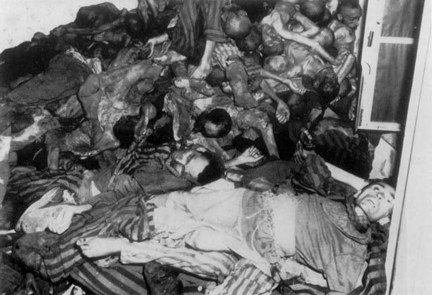
Dead bodies in the
crematorium at Dachau
The American liberators made sure that
residents of Dachau and other towns were forced to confront the
horrors of the concentration camps. According to Harold Marcuse,
in his book "Legacies of Dachau," after the liberation
"a group of Dachau Nazi elite was forced to tour the Dachau
crematorium on 8 May 1945." There they were made to look
at the naked, emaciated bodies of the innocent victims of Nazi
barbarity, piled up in the mortuary room right next to the gas
chamber. Young boys in the Hitler Youth were brought to the camp
and forced to look at the corpses on the Death Train.
The photo below shows one of the emaciated
bodies that was on display at Dachau.
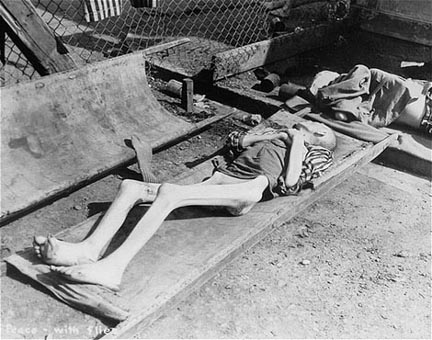
Emaciated body of Dachau
inmate after the liberation
According to Peter Wyden, in his book
"The Hitler Virus," a few of the Dachau notables, who
were forced to view the corpses, fainted. Some cried and many
shook their heads. Most of them turned away, eager to avoid the
scene. Afterwards, they were heard to whisper, "Unglaublich!"
(Unbelievable.) The Dachauers could not understand how the prisoners
could have starved to death since the townspeople had regularly
sent food packages to the camp.
There was a typhus epidemic in the Dachau
camp, but the Dachau townspeople were not sprayed with DDT to
kill the lice that spreads typhus, and they were not vaccinated
before being taken inside the camp and exposed to this disease.
The practice of bringing German civilians
from nearby towns to the concentration camps after they were
liberated was started by General Walton Walker who ordered the
Mayor of the town of Ohrdruf and his wife to visit the Ohrdruf labor camp after it was discovered
by American troops on April 4, 1945. After their visit, the Mayor
and his wife returned home and killed themselves.
General George S. Patton visited the
Ohrdruf camp on April 12th, along with three other generals,
one captured German officer and a few of the citizens of Ohrdruf.
After his visit, General Patton suggested that all the citizens
of Ohrdruf be brought to see the bodies.
The photo below shows the adult citizens
of the village of Ohrdruf viewing the dead bodies found by the
Americans on the roll call square of the labor camp.
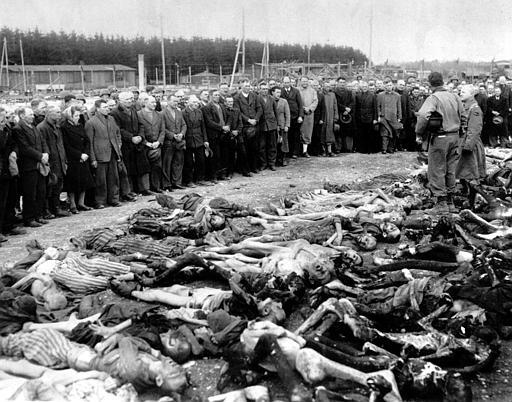
Civilians from town
of Ohrdruf were forced to view the bodies
Buchenwald had been liberated on April
11, 1945 and four days later, the citizens of Weimar were force
marched at gunpoint five miles uphill to see the dead bodies
in the camp. General Patton arrived at Buchenwald the same day
and watched the reactions of the townspeople, as they filed past
the rotting corpses with handkerchiefs over their noses.
A film, made during the visit of the
Dachau citizens to the concentration camp, was included in a
movie called Todesmühlen (Death Mills). This movie was part
of the re-education program for the German people, who were made
to feel personally responsible for what happened in all the concentration
camps. This YouTube
video shows scenes that were included in the Death Mills
movie.
According to the United States Holocaust
Memorial Museum, between April 15 and April 20, 1945, there were
9,300 prisoners in the main Flossenbürg concentration camp,
including approximately 1,700 Jews, who were evacuated to Dachau
on foot and on trains. Around 2,000 sick prisoners had been left
behind.
There were also around 7,000 prisoners,
that had been previously evacuated from Buchenwald on the Death Train to Flossenbürg,
who joined the evacuation out of Flossenbürg. The trains
stopped in the town of Namering where the citizens brought food
and water to the prisoners.
In the town of Namering, 800 prisoners
who had died during the evacuation were buried by the SS men
guarding the trains. On May 17, 1945, American soldiers forced
the people in the town of Namering to dig up the bodies and bury
them in individual graves. The photo below shows an American
soldier instructing the town's people in their guilt for allowing
these prisoners to die.

Citizens of Namering
are told of their guilt, May 17, 1945
In the introduction to his book entitled
"After the Reich," Giles MacDonogh wrote:
The war had been the bloodiest yet,
particularly for civilians. Laying aside some three million dead
German soldiers, by 7 May 1945 at least 1.8 million German civilians
had perished and 3.6 million homes had been destroyed (20 percent
of the total), leaving 7.5 million homeless...
The German civilians in the small towns
like Namering and Dachau had not suffered as much as the citizens
of Berlin or Dresden, so they could still feel sympathy for the
prisoners who had died in the camps and on evacuation trains.
According to Sybille Steinbacher, who
wrote a book entitled "Dachau: The Town and the Concentration
Camp," the US Army commandant of the town after the liberation
spoke angrily to the 30 Dachauers on the day that they were brought
to see the camp. He told them, "As punishment for the brutality
that the town tolerated next door to it, it should be sacked
and turned into ashes!"
The town priest, Father Friedrich Pfanzelt,
who was among the visitors, pleaded with the Americans not to
destroy the town. In a series of articles in 1981, a Dachau newspaper
named the Dachauer Nachrichten wrote about how the priest saved
the town: "On his knees, the prelate pleaded for mercy for
Dachau."
According to Peter Wyden, author of "The
Hitler Virus," 90 percent of the residents of Dachau were
Catholic. Regarding Father Pfanzelt, Wyden wrote: "Then,
from the pulpit of his St. Jacob's Church three days later, the
priest set in motion Dachau's great trauma, the protestation
of innocence, the denial of guilt that would never leave the
community."
Of all people, Father Pfanzelt should
have been aware of the atrocities committed inside the Dachau
concentration camp. According to Wyden, "For years the SS
had extended him the privilege of conducting Sunday services
in the KZ. And he had reciprocated with many ingratiating letters
(which Steinbacher found) and had taken pride in his cordial
relations with most of the camp commandants."
Father Pfanzelt died in 1958 without
ever confirming or denying that he had saved the town from the
wrath of the Americans.
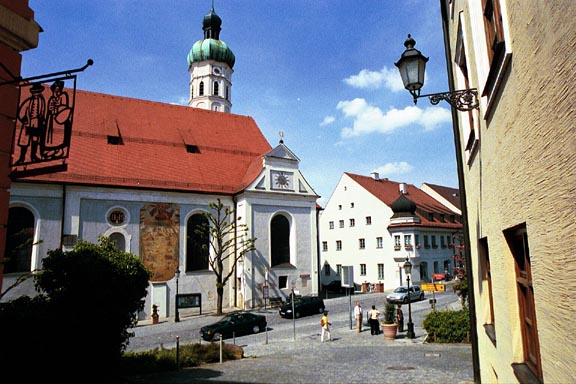
St. Jakob church and
adjacent Baroque building
Today, Dachau is a beautiful town and
St. Jacob's Church still stands. This beautiful Baroque church
is shown in the photo above. No one knows if this story is true
or not, but it is possible that Father Pfanzelt really did save
Dachau from the same fate as Oradour-sur-Glane in France, which was destroyed
by SS soldiers because the residents of the town were believed
to be aiding the French resistance.
The photograph below shows German civilians
burying the bodies on Leitenberg hill. According to author Peter
Wyden, "Leading party members were made to bury the dead."
Wyden also wrote that "the Americans recruited Dachau women
to clean up the boxcars of the death train."
Some of the bodies were so decomposed
that they were falling apart, as the photograph below shows.
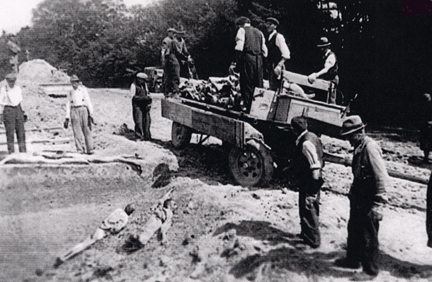
Civilians burying decomposed
bodies at Leitenberg
Photo credit: Donald
E. Jackson, 40th Combat Engineer Regiment
The Official Report by the U.S. Seventh
Army devoted a lot of space to The Townspeople of Dachau. According
to the Report, the townspeople would tell the Americans: "Wir
sind aberall belogen worden." (We have all been lied to.)
The townspeople admitted that they knew the camp existed, that
they saw work-details of inmates passing through the streets
under guard on their way to the 12 work sites in the town, that
"in some instances" (particularly in the years 34 and
35) the SS behaved brutally - towards the townspeople, according
the The Official Report.
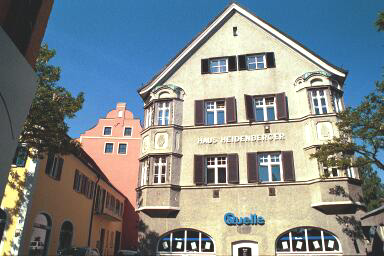
SS soldiers danced
with local girls in the Cafe Belstler
As an example of the brutality of the
SS men toward the townspeople, on New Year's Eve in 1940, the
Cafe Belstler was the scene of a brawl when SS soldiers fought
with the locals. On the same night, SS men slugged it out with
guests at the Zieglerbräu and the Kochwirt Restaurant.
"Was können wir tun?"
(What could we have done?) According to the Official Report,
this statement would seem to represent the most popular attitude
in the town of Dachau at present. The townspeople told the Americans
that in the last years of the war, large numbers of the concentration
camp guards were men who had been drafted into the SS against
their will. German prisoners in the camp were also recruited
to fight on the battlefield with the Waffen-SS in the last days
of the war.
The following quote is from The Official
Report by the U.S. Seventh Army:
Several inmates also told the story
of how, in last October, a whole SS Regiment was recruited -
from of all sources, the inmates of Dachau Concentration Camp.
These men were all Reichsdeutsche and under 40 years old. They
were given no choice.
[...]
Although the population as a whole
realized the utter bestiality of the SS and the nauseating occurrences
beyond the barred gates of the Camp, they were afraid even to
say anything - much less do anything - because the shadow of
the Camp hung over them as well.
[...]
These people admit that the town as
a whole did a thriving business as a result of the presence of
the Camp and its attendant SS "Bonzen" (Big Shots)
- and it is perhaps not without significance that the most outspoken
anti-Nazis were people who, so to speak, could afford to be so
by reason of the fact that their business did not bring them
in daily contact with the SS.
Dachau
residents forced to bring food
Typhus epidemic
at Dachau
Old
photos taken after the liberation
40th Combat
Engineers at Dachau
Previous
Back to Dachau
Liberation
Back to Table
of Contents
Home
This page was last updated on October
10, 2009
German civilians brought to see the camps The American liberators made sure that residents of Dachau and other towns were forced to confront the horrors of the concentration camps. According to Harold Marcuse, in his book "Legacies of Dachau," after the liberation "a group of Dachau Nazi elite was forced to tour the Dachau crematorium on 8 May 1945." There they were made to look at the naked, emaciated bodies of the innocent victims of Nazi barbarity, piled up in the mortuary room right next to the gas chamber. Young boys in the Hitler Youth were brought to the camp and forced to look at the corpses on the Death Train. The photo below shows one of the emaciated bodies that was on display at Dachau.  According to Peter Wyden, in his book "The Hitler Virus," a few of the Dachau notables, who were forced to view the corpses, fainted. Some cried and many shook their heads. Most of them turned away, eager to avoid the scene. Afterwards, they were heard to whisper, "Unglaublich!" (Unbelievable.) The Dachauers could not understand how the prisoners could have starved to death since the townspeople had regularly sent food packages to the camp. There was a typhus epidemic in the Dachau camp, but the Dachau townspeople were not sprayed with DDT to kill the lice that spreads typhus, and they were not vaccinated before being taken inside the camp and exposed to this disease. The practice of bringing German civilians from nearby towns to the concentration camps after they were liberated was started by General Walton Walker who ordered the Mayor of the town of Ohrdruf and his wife to visit the Ohrdruf labor camp after it was discovered by American troops on April 4, 1945. After their visit, the Mayor and his wife returned home and killed themselves. General George S. Patton visited the Ohrdruf camp on April 12th, along with three other generals, one captured German officer and a few of the citizens of Ohrdruf. After his visit, General Patton suggested that all the citizens of Ohrdruf be brought to see the bodies. The photo below shows the adult citizens of the village of Ohrdruf viewing the dead bodies found by the Americans on the roll call square of the labor camp.  Buchenwald had been liberated on April 11, 1945 and four days later, the citizens of Weimar were force marched at gunpoint five miles uphill to see the dead bodies in the camp. General Patton arrived at Buchenwald the same day and watched the reactions of the townspeople, as they filed past the rotting corpses with handkerchiefs over their noses. A film, made during the visit of the Dachau citizens to the concentration camp, was included in a movie called Todesmühlen (Death Mills). This movie was part of the re-education program for the German people, who were made to feel personally responsible for what happened in all the concentration camps. This YouTube video shows scenes that were included in the Death Mills movie. According to the United States Holocaust Memorial Museum, between April 15 and April 20, 1945, there were 9,300 prisoners in the main Flossenbürg concentration camp, including approximately 1,700 Jews, who were evacuated to Dachau on foot and on trains. Around 2,000 sick prisoners had been left behind. There were also around 7,000 prisoners, that had been previously evacuated from Buchenwald on the Death Train to Flossenbürg, who joined the evacuation out of Flossenbürg. The trains stopped in the town of Namering where the citizens brought food and water to the prisoners. In the town of Namering, 800 prisoners who had died during the evacuation were buried by the SS men guarding the trains. On May 17, 1945, American soldiers forced the people in the town of Namering to dig up the bodies and bury them in individual graves. The photo below shows an American soldier instructing the town's people in their guilt for allowing these prisoners to die.  In the introduction to his book entitled "After the Reich," Giles MacDonogh wrote: The war had been the bloodiest yet, particularly for civilians. Laying aside some three million dead German soldiers, by 7 May 1945 at least 1.8 million German civilians had perished and 3.6 million homes had been destroyed (20 percent of the total), leaving 7.5 million homeless... The German civilians in the small towns like Namering and Dachau had not suffered as much as the citizens of Berlin or Dresden, so they could still feel sympathy for the prisoners who had died in the camps and on evacuation trains. According to Sybille Steinbacher, who wrote a book entitled "Dachau: The Town and the Concentration Camp," the US Army commandant of the town after the liberation spoke angrily to the 30 Dachauers on the day that they were brought to see the camp. He told them, "As punishment for the brutality that the town tolerated next door to it, it should be sacked and turned into ashes!" The town priest, Father Friedrich Pfanzelt, who was among the visitors, pleaded with the Americans not to destroy the town. In a series of articles in 1981, a Dachau newspaper named the Dachauer Nachrichten wrote about how the priest saved the town: "On his knees, the prelate pleaded for mercy for Dachau." According to Peter Wyden, author of "The Hitler Virus," 90 percent of the residents of Dachau were Catholic. Regarding Father Pfanzelt, Wyden wrote: "Then, from the pulpit of his St. Jacob's Church three days later, the priest set in motion Dachau's great trauma, the protestation of innocence, the denial of guilt that would never leave the community." Of all people, Father Pfanzelt should have been aware of the atrocities committed inside the Dachau concentration camp. According to Wyden, "For years the SS had extended him the privilege of conducting Sunday services in the KZ. And he had reciprocated with many ingratiating letters (which Steinbacher found) and had taken pride in his cordial relations with most of the camp commandants." Father Pfanzelt died in 1958 without ever confirming or denying that he had saved the town from the wrath of the Americans.  Today, Dachau is a beautiful town and St. Jacob's Church still stands. This beautiful Baroque church is shown in the photo above. No one knows if this story is true or not, but it is possible that Father Pfanzelt really did save Dachau from the same fate as Oradour-sur-Glane in France, which was destroyed by SS soldiers because the residents of the town were believed to be aiding the French resistance. The photograph below shows German civilians burying the bodies on Leitenberg hill. According to author Peter Wyden, "Leading party members were made to bury the dead." Wyden also wrote that "the Americans recruited Dachau women to clean up the boxcars of the death train." Some of the bodies were so decomposed that they were falling apart, as the photograph below shows.  The Official Report by the U.S. Seventh Army devoted a lot of space to The Townspeople of Dachau. According to the Report, the townspeople would tell the Americans: "Wir sind aberall belogen worden." (We have all been lied to.) The townspeople admitted that they knew the camp existed, that they saw work-details of inmates passing through the streets under guard on their way to the 12 work sites in the town, that "in some instances" (particularly in the years 34 and 35) the SS behaved brutally - towards the townspeople, according the The Official Report.  As an example of the brutality of the SS men toward the townspeople, on New Year's Eve in 1940, the Cafe Belstler was the scene of a brawl when SS soldiers fought with the locals. On the same night, SS men slugged it out with guests at the Zieglerbräu and the Kochwirt Restaurant. "Was können wir tun?" (What could we have done?) According to the Official Report, this statement would seem to represent the most popular attitude in the town of Dachau at present. The townspeople told the Americans that in the last years of the war, large numbers of the concentration camp guards were men who had been drafted into the SS against their will. German prisoners in the camp were also recruited to fight on the battlefield with the Waffen-SS in the last days of the war. The following quote is from The Official Report by the U.S. Seventh Army: Several inmates also told the story of how, in last October, a whole SS Regiment was recruited - from of all sources, the inmates of Dachau Concentration Camp. These men were all Reichsdeutsche and under 40 years old. They were given no choice. [...] Although the population as a whole realized the utter bestiality of the SS and the nauseating occurrences beyond the barred gates of the Camp, they were afraid even to say anything - much less do anything - because the shadow of the Camp hung over them as well. [...] These people admit that the town as a whole did a thriving business as a result of the presence of the Camp and its attendant SS "Bonzen" (Big Shots) - and it is perhaps not without significance that the most outspoken anti-Nazis were people who, so to speak, could afford to be so by reason of the fact that their business did not bring them in daily contact with the SS. Dachau residents forced to bring foodTyphus epidemic at DachauOld photos taken after the liberation40th Combat Engineers at DachauPreviousBack to Dachau LiberationBack to Table of ContentsHomeThis page was last updated on October 10, 2009 |